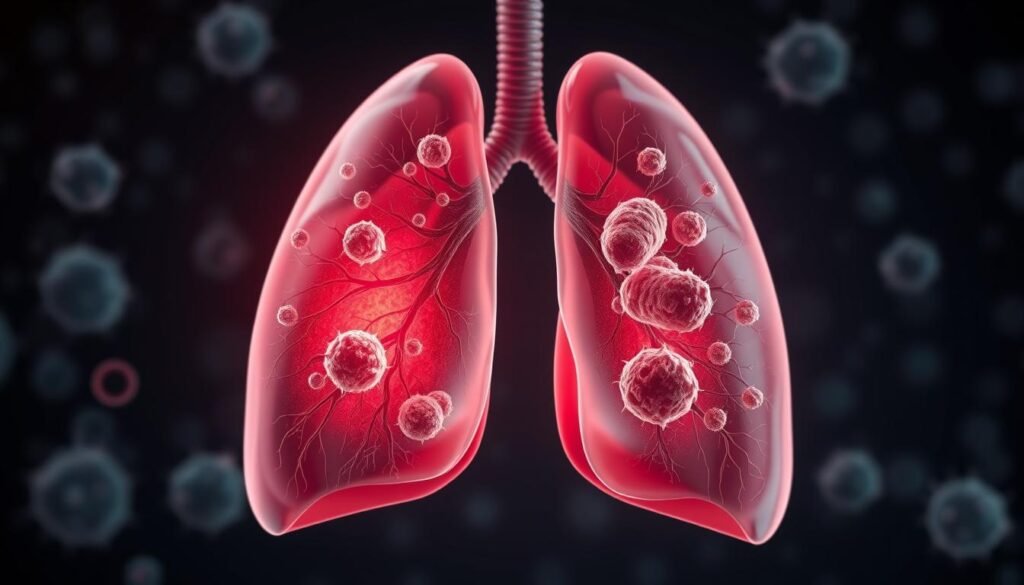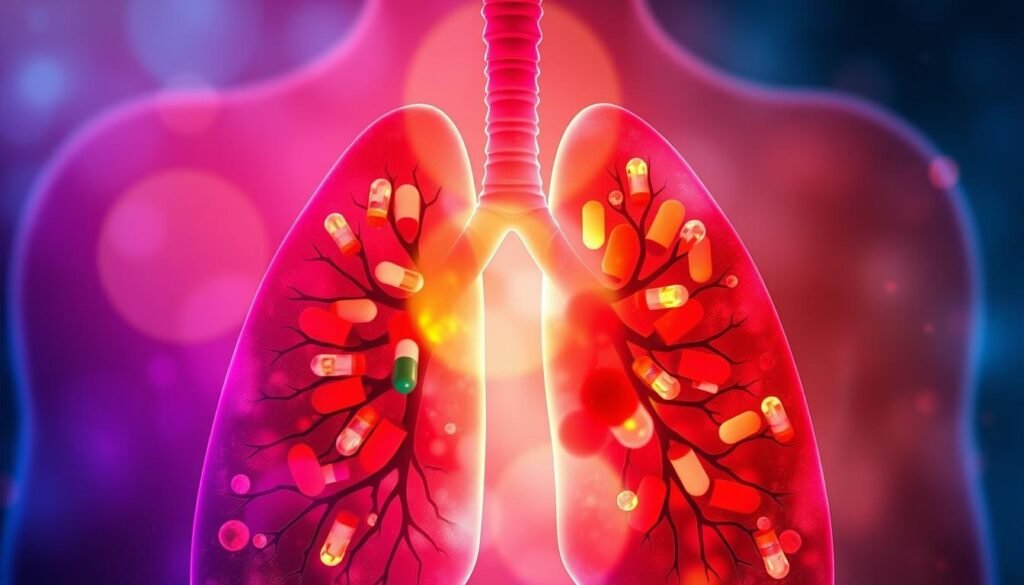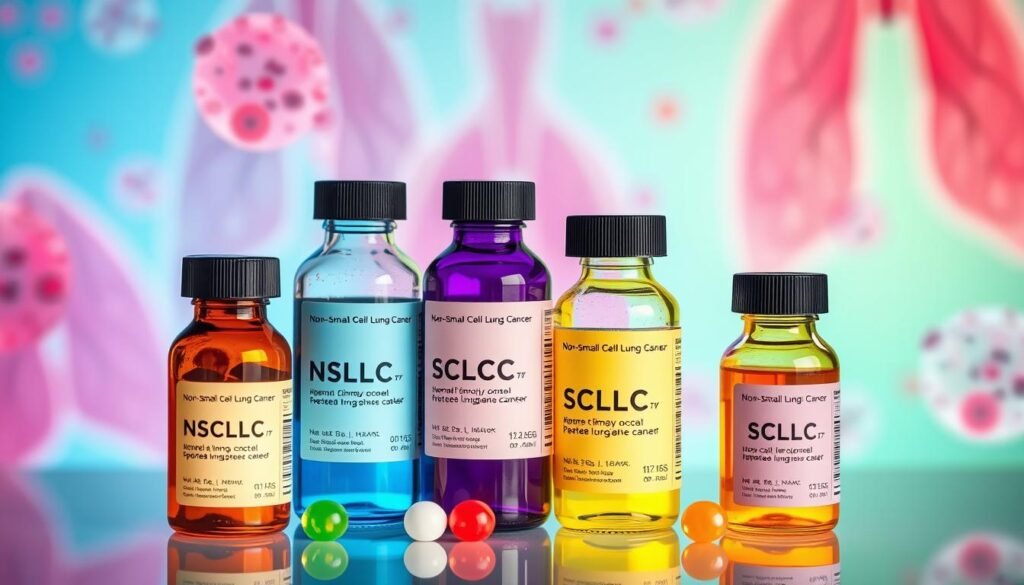About 234,000 new cases of lung cancer will be found in the U.S. this year. That’s a lot and shows why good treatment methods are crucial. Chemotherapy is key in fighting non-small cell lung cancer (NSCLC) and small cell lung cancer (SCLC). Knowing about the drugs used, how they work, and their uses helps patients choose their treatment paths.
When it comes to battling lung cancer, chemotherapy drugs are at the forefront. They range from meds like cisplatin and carboplatin to targeted treatments like EGFR inhibitors. These therapies are given in cycles to help the body mend, and new strategies like immunotherapy tailor treatments to each patient. We’ll look into how these drugs work, their success, and their critical role in lung cancer care.
Key Takeaways
- Chemotherapy is vital for treating both NSCLC and SCLC.
- Typical chemotherapy drugs are cisplatin, carboplatin, and pemetrexed.
- Targeted therapies hone in on specific cancer cell activities.
- Immunotherapy is a hopeful direction in fighting lung cancer.
- Knowing how drugs work assists patients in making treatment choices.
Understanding Lung Cancer Types
Lung cancer is mainly of two types: non-small cell lung cancer (NSCLC) and small cell lung cancer (SCLC). NSCLC makes up about 80-85% of all lung cancers. It includes types like adenocarcinoma and squamous cell carcinoma. These lung cancers have unique lung cancer characteristics impacting diagnosis and treatment.
SCLC is less common but very aggressive. It grows quickly, often in those who’ve smoked a lot. Unlike NSCLC, SCLC is rare in non-smokers. Each lung cancer type has lung cancer characteristics needing specific treatments.
The following table summarizes the key differences between NSCLC and SCLC:
| Characteristic | NSCLC | SCLC |
|---|---|---|
| Prevalence | 80-85% of lung cancers | 15-20% of lung cancers |
| Growth Rate | Slower | Rapid |
| Common Subtypes | Adenocarcinoma, Squamous Cell Carcinoma | Small Cell Carcinoma |
| Treatment Options | Surgery, chemotherapy, targeted therapy | Chemotherapy, radiation therapy |
| Prognosis | Generally better with early detection | Poor, often diagnosed at advanced stages |
Understanding the differences between NSCLC and SCLC helps. It helps patients and doctors choose the best treatment plans. This is based on the cancer’s details and the person’s situation.
What is Non-Small Cell Lung Cancer (NSCLC)?
Non-small cell lung cancer (NSCLC) is the most common lung cancer type, making up about 85% of cases. It includes different subtypes like adenocarcinoma, squamous cell carcinoma, and large cell carcinoma. Each one has its own traits and impacts on treatment and outlook.
Smoking is a big risk factor for NSCLC, being behind 80% of cases. Other risks come from secondhand smoke and harmful chemicals like arsenic, asbestos, and radon. This cancer is mostly seen in older adults, being rare in those under 45.
Doctors use imaging tests like chest X-rays and CT scans to spot NSCLC. They also do biopsies to check for cancer cells. Knowing the stage, which ranges from 0 to IV, is vital. It depends on tumor size, lymph node involvement, and if it has spread.
In treating NSCLC, several methods are key. Surgery is often the go-to for early stages. Chemotherapy is crucial for Stage IV, either before or after surgery to boost results. Advanced stages may see benefits from new treatments like immunotherapy and targeted therapy. These can help extend life and better quality of life. Sometimes, doctors add radiation therapy to chemotherapy for better effects.

The speed of NSCLC growth varies. Some types grow slowly, while others quickly worsen. Spotting it early and starting treatment right away is critical. This helps manage this common cancer more effectively.
Overview of Small Cell Lung Cancer (SCLC)
Small Cell Lung Cancer (SCLC) makes up about 15% of all lung cancers. It’s known for being very aggressive and closely linked to smoking. Its fast growth and early spread highlight the need for quick and effective treatment.
About 30% of those with SCLC are diagnosed when it’s still in the early stage. The rest have a more widespread form of the disease. SCLC is still a major health issue in the U.S. Experts think there will be 234,580 new lung cancer cases in 2024. This includes both SCLC and non-small cell lung cancer (NSCLC).
It’s vital to know the treatment options for SCLC to help patients do better. For early-stage disease, combining chemotherapy with radiation (chemoradiation) works best. But for advanced SCLC, chemotherapy alone is the usual route, sometimes with added immunotherapy.
The top chemotherapy combos are cisplatin with etoposide, or carboplatin with etoposide. If the disease doesn’t respond, drugs like topotecan and lurbinectedin are next up. Chemotherapy is given in cycles, usually over 3 to 4 weeks, with about 4 to 6 cycles in total.
Survival rates for SCLC depend on the stage at diagnosis. The 5-year survival rate is low, between 5% to 10%. But, people with early-stage disease have a better outlook, about a 14% survival rate. For them, the median survival time is 16 to 24 months. Sadly, those with advanced disease often live just 6 to 12 months.
Some patients may live longer with preventative brain radiation. Knowing all about SCLC and the latest treatments is crucial for health care experts. For in-depth info on SCLC and its treatments, the National Center for Biotechnology Information is a great resource.
Importance of Chemotherapy in Lung Cancer Treatment
Chemotherapy is crucial in treating lung cancer. It’s key for curing or managing cases where surgery isn’t possible. In 2012, there were 1.8 million new lung cancer cases and 1.59 million deaths worldwide. This shows how vital chemotherapy is.
Before surgery, chemotherapy helps shrink tumors, a method called neoadjuvant therapy. This leads to better surgery results and can boost survival rates. For example, patients treated with platinum-based chemotherapy had a 15% one-year survival rate. That’s three times higher than with supportive care. Chemotherapy also kills remaining cancer cells after surgery, known as adjuvant therapy.

In advanced lung cancer, chemotherapy is often the main treatment when surgery isn’t an option. About 55% of patients with advanced non-small cell lung cancer need it. When combined with radiation, this chemoradiation improves survival in certain lung cancers.
Using multiple chemotherapy drugs usually works better than one alone. For instance, combining cisplatin or carboplatin with gemcitabine or paclitaxel is effective. Such therapies extend the benefits of initial treatments, anchoring comprehensive care plans.
Chemotherapy’s role in lung cancer treatment is undeniable. It offers hope from the start through maintenance therapy, aiming to extend life and improve patient well-being.
Chemotherapy Drugs for Non-Small Cell and Small Cell Lung Cancer
Chemotherapy is key in treating both non-small cell lung cancer and small cell lung cancer. It offers different options for patients. The success of treatment often depends on choosing the right chemotherapy drugs for each type of cancer.
Commonly Used Chemotherapy Drugs
Several drugs work well against non-small cell lung cancer. These include cisplatin, carboplatin, pemetrexed, paclitaxel, and docetaxel. Selecting the best drug based on the patient’s unique situation can greatly affect the outcome.
Small cell lung cancer often needs a strong treatment strategy. Key drugs for SCLC include etoposide, often used with cisplatin or carboplatin. Other options are topotecan, irinotecan, and ifosfamide. Combinations like etoposide and cisplatin usually give better results in treatment.
Combination Therapy Strategies
Combination therapy uses multiple drugs at once. This makes it more likely to kill the cancer cells while reducing side effects. For SCLC, combinations like etoposide and cisplatin are common. They offer promising chances of success.
This approach to treatment is crafted to fight off drug resistance and improve results. Research shows that patients on well-planned combination therapies often live longer. For more on the latest in lung cancer treatments and chemotherapy’s role, visit this informative resource.

Mechanism of Action: How Chemotherapy Works
Chemotherapy plays a crucial role in fighting cancer. It focuses on how it works against various cancers, like non-small cell lung cancer (NSCLC). These drugs are designed to target and disrupt cell division. This stops cancer cells from growing and spreading.
Cancer cells divide faster than healthy cells. Chemotherapy takes advantage of this by targeting fast-dividing cancer cells. This means it harms cancer cells more than healthy ones. This is why chemotherapy is a powerful tool in battling cancers like NSCLC.
Understanding how chemotherapy can be tailored is important. For advanced NSCLC, specific therapies may be needed. These focus on cancer’s genetic changes. Targeting mutations in genes like EGFR, KRAS, ALK, and ROS1 can make chemotherapy more effective.
| Chemotherapy Agent | General Mechanism | Common Side Effects |
|---|---|---|
| EGFR Inhibitors | Target specific mutations to slow down cell growth | Skin problems, nail changes, fatigue, loss of appetite |
| ALK Inhibitors | Inhibit signals that promote cancer cell division | Nausea, vomiting, vision changes, peripheral neuropathy |
| KRAS Inhibitors | Block pathways that aid tumor growth | Diarrhea, nausea, fatigue, muscle pain |
| ROS1 Inhibitors | Disrupt growth signals associated with specific mutations | Vision changes, fatigue, muscle soreness |
| BRAF Inhibitors | Target mutations in the BRAF gene that promote cancer | Skin thickening, rash, sensitivity to sunlight |
Chemotherapy can be given in different ways: injections, drips, tablets, or capsules. This lets the drugs reach cancer cells all over the body. Knowing how chemotherapy works helps doctors plan treatment. It also helps patients understand their treatment paths.
Managing Side Effects of Chemotherapy
Dealing with chemotherapy can be tough. Knowing the possible chemotherapy side effects helps you get ready and find the right cancer patient support. Everyone reacts differently; some might have mild issues, while others face tougher challenges.
Common Side Effects Experienced
Chemotherapy can cause side effects that affect your everyday life. The most common ones include:
- Nausea and vomiting
- Fatigue and weakness
- Hair loss or thinning
- Loss of appetite
- Increased risk of infections due to reduced immunity
- Changes in taste sensation
- Numbness and tingling in extremities
- Menstrual cycle changes in women
Strategies to Cope with Side Effects
Handling side effects is key for a good quality of life during treatment. There are strategies to lessen discomfort:
- Nutritional Support: Eating right around chemo sessions can cut down on nausea. Small meals throughout the day can also be beneficial.
- Hydration: Drinking a lot of water is good for the kidneys and fights dehydration from side effects.
- Medication Adjustments: Talking about anti-nausea drugs with doctors can help keep symptoms in check.
- Physical Activity: Simple exercises might boost your energy and mood when you’re up for it.
- Monitoring Symptoms: Keeping an eye on side effects lets you tell your healthcare team what’s going on.
Managing side effects properly and getting the help you need not only makes treatment easier but also improves your health overall. Using these strategies will make your chemo experience more comfortable and give you strength.
Emerging Therapies: Beyond Traditional Chemotherapy
The treatment for lung cancer is quickly changing, offering new hope. Now, there are new therapies that go beyond the usual chemotherapy. They target the cancer more directly and have fewer side effects. Targeted therapy and immunotherapy are gaining momentum.
Targeted Therapy Options
Targeted therapy works on certain markers in cancer cells. It’s very precise, often designed for the patient’s unique situation. For example, around 40% of people with a certain type of lung cancer have specific EGFR mutations. These mutations react well to EGFR inhibitors. This shows how crucial targeted treatment is.
Moreover, about 5% of a certain lung cancer type has ALK fusion. This highlights the need for treatments that are specific to each person. Knowing the genetics of the cancer improves how well treatments work. That’s why testing for these markers is now a common practice.
Immunotherapy Advances
Immunotherapy is changing how we fight lung cancer. It boosts the body’s own defenses to attack cancer cells. Checkpoint inhibitors, for example, lift some of the brakes on the immune system. This has been effective in several types of lung cancer. These drugs can be used alone or with other drugs in advanced cases.
Also, monoclonal antibodies stop tumors from getting the blood supply they need. This is especially useful in non-small cell lung cancer. The search for new treatments is ongoing. Immunotherapy and targeted therapy have improved the approach to treatment. They offer better chances for survival and a higher quality of life for patients.
| Type of Therapy | Mechanism | Examples |
|---|---|---|
| Targeted Therapy | Targets specific genetic mutations | EGFR inhibitors, ALK inhibitors |
| Immunotherapy | Enhances immune response against cancer | PD-1 inhibitors, CTLA-4 inhibitors |
Conclusion
The fight against lung cancer is ongoing, with chemotherapy as a key weapon. This treatment dramatically helps patients with small cell lung cancer, achieving remission in about 80% of cases. It’s critical to understand the different chemotherapy drugs and plans to best help patients.
Recent progress has combined old and new treatments, like targeted therapy and immunotherapy. These advancements show promise for better outcomes and more personalized care. Even with low survival rates, there’s hope due to these advances in treatment and patient care.
The future of lung cancer care is looking towards research and innovation. Tailoring treatment plans to fit the individual’s needs, based on biomarker testing, is now more important than ever. For more information on chemotherapy for stage IV NSCLC patients, check out this in-depth article.